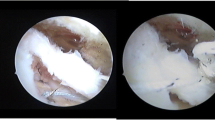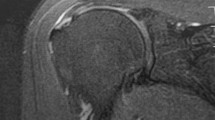Abstract
Purpose
The purpose of this study was to compare arthroscopic rotator cuff repair with single-row and double-row techniques because research has demonstrated the superiority of double-row repair from a biological and mechanical point of view but there is no evidence of clinical superiority.
Methods
A total of 160 patients with a full-thickness rotator cuff tear underwent arthroscopic repair with suture anchors. They were randomised into two groups of 80 patients according to the repair technique: single-row (group 1) and double-row (group 2). Results were evaluated by use of the University of California, Los Angeles (UCLA), American Shoulder and Elbow Surgeons (ASES) and Constant questionnaires, the Shoulder Strength Index (SSI) and range of motion. Follow-up time was two years. Magnetic resonance imaging (MRI) studies were performed on each shoulder preoperatively and two years after repair.
Results
One hundred per cent of the patients were followed up. All measurements showed significant improvement compared with the preoperative status. The UCLA score showed significant improvement in group 2. In over 30-mm tears UCLA and ASES showed significant differences. SSI showed significant improvement in group 2. Range of motion showed significant improvements in flexion and abduction in group 2. In under 30-mm tears group 2 showed also significant improvement in internal and external rotation. In MRI studies there were no significant differences.
Conclusions
At two years follow-up the double-row repair technique showed a significant difference in clinical outcome compared with single-row repair and this was even more significative in over 30-mm tears. No MRI differences were observed.




Similar content being viewed by others
References
Anderson K, Boothby M, Aschenbrener D, van Holsbeeck M (2006) Outcome and structural integrity after arthroscopic rotator cuff repair using 2 rows of fixation: minimum 2-year follow-up. Am J Sports Med 34:1899–1905. doi:10.1177/0363546506290187
Boileau P, Brassart N, Watkinson DJ, Carles M, Hatzidakis AM, Krishnan SG (2005) Arthroscopic repair of full-thickness tears of the supraspinatus: does the tendon really heal? J Bone Joint Surg Am 87(6):1229–1240. doi:10.2106/JBJS.D.02035
Brady PC, Arrioni P, Burkhart SS (2006) Evaluation of residual rotator cuff defects after in vivo single- versus double-row rotator cuff repairs. Arthroscopy 22:1070–1075. doi:10.1016/j.arthro.2006.05.007
Burks RT, Crim J, Brown N, Fink B, Greis PE (2009) A prospective randomized clinical trial comparing arthroscopic single- and double-row rotator cuff repair: magnetic resonance imaging and early clinical evaluation. Am J Sports Med 37:674–682. doi:10.1177/0363546508328115
Charousset C, Grimberg J, Duranthon LD, Bellaiche L, Petrover D (2007) Can a double-row anchorage technique improve tendon healing in arthroscopic rotator cuff repair? A prospective, nonrandomized, comparative study of double-row and single-row anchorage techniques with computed tomographic arthrography tendon healing assessment. Am J Sports Med 35:1247–1253. doi:10.1177/0363546507301661
Curtis AS, Burbank KM, Tierney JJ, Scheller AD, Curran AR (2006) The insertional footprint of the rotator cuff: an anatomic study. Arthroscopy 22(6):609.e1. doi:10.1016/j.arthro.2006.04.001
Franceschi F, Ruzzini L, Longo UG, Martina FM, Zobel BB, Maffulli N, Denaro V (2007) Equivalent clinical results of arthroscopic single-row and double-row suture anchor repair for rotator cuff tears: a randomized controlled trial. Am J Sports Med 35(8):1254–1260. doi:10.1177/0363546507302218
Galatz LM, Ball CM, Teefey SA, Middleton WD, Yamaguchi K (2004) The outcome and repair integrity of completely arthroscopically repaired large and massive rotator cuff tears. J Bone Joint Surg Am 86:219–224
Gerber C, Fuchs B, Hodler J (2000) The results of repair of massive tears of the rotator cuff. J Bone Joint Surg Am 82(4):505–515
Grasso A, Milano G, Salvatore M, Falcone G, Deriu L, Fabbriciani C (2009) Single-row versus double-row arthroscopic rotator cuff repair: a prospective randomized clinical study. Arthroscopy 25(1):4–12. doi:10.1016/j.arthro.2008.09.018
Huijsmans PE, Pritchard MP, Berghs BM, van Rooyen KS, Wallace AL, de Beer JF (2007) Arthroscopic rotator cuff repair with double-row fixation. J Bone Joint Surg Am 89(6):1248–1257. doi:10.2106/JBJS.E.00743
Kim DH, ElAttrache NS, Tibone JE et al (2006) Biomechanical comparison of a single-row versus double-row suture anchor technique for rotator cuff repair. Am J Sports Med 34(3):407–414. doi:10.1177/0363546505281238
Koh K, Kang KC, Lim TK, Shon MS, Yoo JC (2011) Prospective randomized clinical trial of single- versus double-row suture anchor repair in 2- to 4-cm rotator cuff tears: clinical and magnetic resonance imaging results. Arthroscopy 27(4):453–462
Lafosse L, Brozska R, Toussaint B, Gobezie R (2007) The outcome and structural integrity of arthroscopic rotator cuff repair with use of the double-row suture anchor technique. J Bone Joint Surg Am 89:1533–1541
Lo IK, Burkhart SS (2003) Double-row arthroscopic rotator cuff repair: re-establishing the footprint of the rotator cuff. Arthroscopy 19:1035–1042
Meier SW, Meier JD (2006) The effect of double-row fixation on initial repair strength in rotator cuff repair: a biomechanical study. Arthroscopy 22(11):1168–1173. doi:10.1016/j.arthro.2006.07.004
Papalia R, Franceschi F, Del Buono A, Zampogna B, Malffulli N, Denaro V (2011) Double row repair: is it worth the hassle? Sports Med Arthrosc 19(4):342–347
Park MC, ElAttrache NS, Tibone JE, Ahmad CS, Jun BJ, Lee TQ (2007) Part I: footprint contact characteristics for a transosseous-equivalent rotator cuff repair technique compared with a double-row repair technique. J Shoulder Elbow Surg 16:461–468. doi:10.1016/j.jse.2006.09.010
Park JY, Lhee SH, Choi JH, Park HK, Yu JW, Seo JB (2008) Comparison of the clinical outcomes of single- and double-row repairs in rotator cuff tears. Am J Sports Med 36:1310–1316. doi:10.1177/0363546508315039
Park MC, Tibone JE, ElAttrache NS, Ahmad CS, Jun BJ, Lee TQ (2007) Part II: biomechanical assessment for a footprint-restoring transosseous-equivalent rotator cuff repair technique compared with double-row repair technique. J Shoulder Elbow Surg 16(4):469–476. doi:10.1016/j.jse.2006.09.011
Pennington WT, Gibbons DJ, Bartz BA, Dodd M, Daun J, Klinger J, Popovich M, Butler B (2010) Comparative analysis of single-row versus double-row repair of rotator cuff tears. Arthroscopy 26(11):1419–1426
Reardon DJ, Maffulli N (2007) Clinical evidence shows no difference between single- and double-row repair for rotator cuff tears. Arthroscopy 23(6):670–673. doi:10.1016/j.arthro.2007.01.031
Smith CD, Alexander S, Hill AM et al (2006) A biomechanical comparison of single and double-row fixation in arthroscopic rotator cuff repair. J Bone Joint Surg Am 88(11):2425–2431. doi:10.2106/JBJS.E.00697
Sugaya H, Maeda K, Matsuki K, Moriishi J (2007) Repair integrity and functional outcome after arthroscopic double-row rotator cuff repair: a prospective outcome study. J Bone Joint Surg Am 89:953–960. doi:10.2106/JBJS.F.00512
Sugaya H, Maeda K, Matsuki K, Moriishi J (2005) Functional and structural outcome after arthroscopic full-thickness rotator cuff repair: single-row versus dual-row fixation. Arthroscopy 21(11):1307–1316. doi:10.1016/j.arthro.2005.08.011
Author information
Authors and Affiliations
Corresponding author
Additional information
Level of evidence: Level I.
Rights and permissions
About this article
Cite this article
Carbonel, I., Martinez, A.A., Calvo, A. et al. Single-row versus double-row arthroscopic repair in the treatment of rotator cuff tears: a prospective randomized clinical study. International Orthopaedics (SICOT) 36, 1877–1883 (2012). https://doi.org/10.1007/s00264-012-1559-9
Received:
Accepted:
Published:
Issue Date:
DOI: https://doi.org/10.1007/s00264-012-1559-9




